Adolphus Greely
Adolphus Washington Greely (March 27, 1844 – October 20, 1935) was a United States Army officer, polar explorer, and recipient of the Medal of Honor.
Adolphus Greely | |
|---|---|
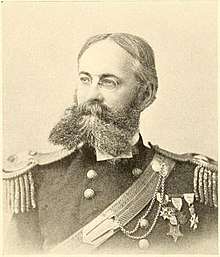 Greely in 1895 | |
| Birth name | Adolphus Washington Greely |
| Born | March 27, 1844 Newburyport, Massachusetts |
| Died | October 20, 1935 (aged 91) Washington, D.C. |
| Buried | |
| Allegiance | |
| Branch | |
| Service years | 1861–1908 |
| Rank | Major general |
| Awards |
|
| Signature | |
He was the son of John Balch Greeley and Frances Dunn Cobb Greeley. He was a third cousin of American author and statesman Horace Greeley.
Early military career
He began his long and distinguished military career shortly after the outbreak of the American Civil War. On 26 July 1861, he enlisted in the 19th Massachusetts Infantry Regiment at the age of 17, after having been rejected twice before. Over the next two years he worked his way up the enlisted ranks to 1st sergeant.
On 18 March 1863, he was commissioned as a second lieutenant in the 81st United States Colored Infantry. He was promoted to 1st lieutenant on 26 April 1864 and to captain on 4 April 1865. After the war he received a brevet promotion to major to rank from 13 March 1865 for "faithful and meritorious service during the war". He was mustered out of the Volunteer Army on 22 March 1867.
He was commissioned as a second lieutenant in the 36th Infantry Regiment of the Regular Army on 7 March 1867 and was reassigned to the 5th Cavalry Regiment on 14 July 1869 after the 36th Infantry was disbanded. He was promoted to first lieutenant on 27 May 1873.[1]
Lady Franklin Bay Expedition
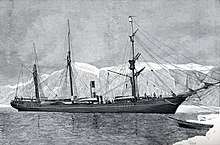
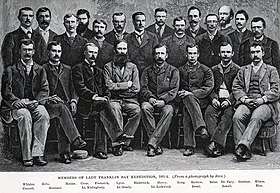
In 1881, First Lieutenant Greely was given command of the Lady Franklin Bay Expedition on the ship Proteus. Promoted by Henry W. Howgate, its purpose was to establish one of a chain of meteorological-observation stations as part of the First International Polar Year.[2] The expedition also was commissioned by the US government to collect astronomical and polar magnetic data, which was carried out by the astronomer Edward Israel, who was part of Greely's crew. Another goal of the expedition was to search for any clues of the USS Jeannette, lost in the Arctic two years earlier.[3]
Greely was without previous Arctic experience, but he and his party were able to discover many hitherto unknown miles along the coast of northwest Greenland. The expedition also crossed Ellesmere Island from east to west and Lt. James B. Lockwood and Sgt. David Legge Brainard achieved a new "farthest north" record of 83°23'8" on Lockwood Island.[4]
In 1882, Greely sighted a mountain range during a dog sledding exploration to the interior of northern Ellesmere Island and named them the Conger Range. He also sighted the Innuitian Mountains from Lake Hazen.
Two consecutive supply parties failed to reach Greely's party encamped at Fort Conger on Ellesmere Island in 1882 and 1883. In accordance with his instructions for this case, Greely decided in August 1883 to abandon Fort Conger and retreat south with his team. They reached Cape Sabine expecting to find food and equipment depots from the supply ships, but these had not been provided. With winter setting in Greely and his men were forced to winter at Cape Sabine with inadequate rations and little fuel.[5]
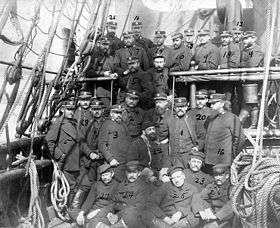
A rescue expedition, led by Capt. Winfield Scott Schley on the USRC Bear (a former whaler built in Greenock, Scotland), was sent to rescue the Greely party. By the time Bear and ships Thetis and Alert arrived on June 22, 1884, to rescue the expedition, nineteen of Greely's 25-man crew had perished from starvation, drowning, hypothermia, and, in the case of Private Henry, gunshot wounds from an execution ordered by Greely.[6][7]
%2C_1827-1909_3.jpg)
Greely and the other survivors were themselves near death; one of the survivors died on the homeward journey. The returning survivors were venerated as heroes, though the heroism was tainted by sensational accusations of cannibalism during the remaining days of low food.[8]
An exhibition on the "Greely expedition" was part of the Columbian Exposition in 1893 and was captured on stereoscopic images.
Later career
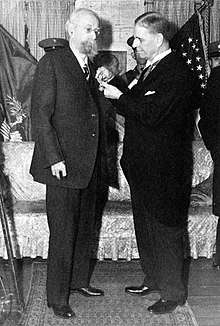
In June 1886, Greely was promoted to captain after serving twenty years as a lieutenant and, in March 1887, President Grover Cleveland appointed him as Chief Signal Officer of the U.S. Army with the rank of brigadier general.
During his tenure as Chief Signal Officer of the Army, the following military telegraph lines were constructed, operated and maintained during the Spanish–American War: Puerto Rico, 800 miles (1,300 kilometers); Cuba, 3,000 mi (4,800 km); the Philippines, 10,200 mi (16,400 km). In connection with Alaska, then General Greely had constructed under very adverse conditions a telegraph system of nearly 4,000 mi (6,400 km), consisting of submarine cables, land cables and wireless telegraphy, the latter covering a distance of 107 mi (172 km), which at the time of installation was the longest commercial system regularly working in the world.
In 1906, he served as military commander over the emergency situation created by the San Francisco earthquake. On February 10, 1906, he was promoted to major general and on March 27, 1908, after over 46 years of service, he retired from the Army, having reached the mandatory retirement age of 64. In 1911 he represented the United States Army at the coronation of King George V.
On March 21, 1935, a special act of Congress awarded Greely the Medal of Honor in recognition of his long and distinguished career. He is the second person (after SGM Frederick William Gerber) to be awarded the Medal of Honor for "lifetime achievement" rather than for acts of physical courage at the risk of one's own life. His was the second and last award of the Medal of Honor by the Army for non-combat service.[9] (The other was to Charles A. Lindbergh for his solo flight across the Atlantic Ocean.[10])
General Greely died on October 20, 1935, in Washington, D.C., and is buried in Arlington National Cemetery, Arlington, Virginia.
Personal life
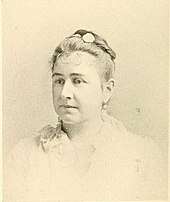
Greely attended the First Presbyterian Church of Newburyport. He married Henrietta Nesmith in 1878; they had six children, among whom was the landscape architect Rose Greely.[11] Henrietta was a member of the Daughters of the American Revolution and one of the founding vice presidents general of the Children of the American Revolution.
After the Civil War, Greely became a companion of the District of Columbia Commandery of the Military Order of the Loyal Legion of the United States – a military society composed of Union officers and their descendants. He was also a member of the Sons of the Revolution, the General Society of the War of 1812 and the Grand Army of the Republic.
In 1890, he became a founding member of the District of Columbia Society of the Sons of the American Revolution (SAR) and was elected as the society's vice president. Upon the death of Admiral David D. Porter in February 1891, Greely became president of the District of Columbia Society of the SAR and served until the end of 1892. [12]
In retirement General Greely resided at 1635 R Street N.W. in Washington, D.C. He was member of the Cosmos Club. In 1905, he accepted the honor of serving as the first president of The Explorers Club and in 1915, he invited the Italian polar geographer Arnaldo Faustini to the United States for a lecture tour.
Honors and awards
General Greely received the Medal of Honor in 1935: "For his life of splendid public service, begun on March 27, 1844, having enlisted as a private in the U.S. Army on July 26, 1861, and by successive promotions was commissioned as major general February 10, 1906, and retired by operation of law on his 64th birthday."
Greely's medal was awarded in contradiction to the revised 1916 Army warrant requiring combat action and risk of life "above and beyond the call of duty."[13] However, his medal was the second, and last, Army presentation contrary to the combat requirement, as Charles Lindbergh (an Army reservist not on active duty) received the award for his solo transatlantic flight eight years before, in 1927. Until after WWII the Navy Medal of Honor could be awarded for noncombat actions, reflecting different criteria within the United States armed forces.
He was awarded the Royal Geographical Society's Founder's Medal in 1886,[14] and the American Geographical Society's Charles P. Daly Medal in 1922.[15] USS General A. W. Greely (AP-141) and Fort Greely were named in his honor.
Dates of Rank
- Enlisted, 19th Massachusetts Volunteer Infantry - 26 July 1861
- 2nd Lieutenant, 81st US Colored Infantry - 18 March 1863
- 1st Lieutenant, 81st US Colored Infantry - 26 April 1864
- Captain, 81st US Colored Infantry - 4 April 1865
- Brevet Major, Volunteers - 13 March 1865
- Mustered out of Volunteers - 22 March 1867
- 2nd Lieutenant, 36th Infantry - 7 March 1867
- 2nd Lieutenant, 5th Cavalry - 14 July 1869
- 1st Lieutenant, 5th Cavalry - 27 May 1873
- Captain, 5th Cavalry - 11 June 1886
- Brigadier General, Chief Signal Officer - 3 March 1887
- Major General, US Army - 10 February 1906
- Retired - 27 March 1908 [16]
See also
- Greely Island
- List of Medal of Honor recipients during Peacetime
Works
- Three Years of Arctic Service (1886)
- Handbook of Alaska (rev. ed. 1925)
- Reminiscences of Adventure and Service (1927)
- The Polar Regions in the Twentieth Century (1928).
References
- Historical Register and Dictionary of the United States Army, 1789 to 1903. Francis B. Heitman. Vol. 1, pg. 473.
- Guttridge, Leonard F. (September 1, 2000). "Ghosts of Cape Sabine: the harrowing true story of the Greely expedition". Arctic Institute of North America of the University of Calgary. Retrieved April 14, 2008.
- Berton, Pierre (1988). The Arctic Grail: The Quest for the North West Passage and the North Pole. Toronto: Random House of Canada Ltd., p. 437
- Geographical Items on North Greenland Encyclopedia Arctica 14: Greenland
- Lotz, J. 2009. Canada's Forgotten Arctic Hero: George Rice and the Lady Franklin Bay Expedition, 1881-1884. Breton Books, Wreck Cove, Nova Scotia. ISBN 1-895415-94-2
- Schley, Winfield S Commander, US Navy [1887] 1884 Greely Relief Expedition Washington Printing Office (via American Libraries)
- 'ENGLAND'S PRESENT TO AMERICA.; THE STEAM-SHIP ALERT FOR THE GREELY SEARCH EXPEDITION' 4/23/1884 New York Times.(via NYT Archives)
- "American Experience: The Greely Expedition". pbs.org. Retrieved February 1, 2011.
- Schwoch, James (In press, 2018). Wired into Nature: The Telegraph and the North American Frontier. Urbana: Univ. of Illinois Press.
- Schwoch, James (In press, 2018). Wired into Nature: The Telegraph and the North American Frontier. Urbana: Univ. of Illinois Press.
- "Adolphus W. Greely (1844–1935) Papers, 1844–1871; 1908–1909" (PDF). Peabody Essex Museum. January 2012. Retrieved October 2, 2015.
- Register of the District of Columbia Society of the Sons of the American Revolution. 1896. William J. Rhees. pg. VIII.
- Barrett Tillman. Heroes: U.S. Army Medal of Honor recipients. New York: Berkeley, 2006, p. 94
- "List of Past Gold Medal Winners" (PDF). Royal Geographical Society. Archived from the original (PDF) on September 27, 2011. Retrieved August 24, 2015.
- "American Geographical Society Honorary Fellowships" (PDF). amergeog.org. Archived from the original (PDF) on March 26, 2009. Retrieved March 2, 2009.
- Historical Register and Dictionary of the United States Army, 1789 to 1903. Francis B. Heitman. Vol. 1, pg. 473.
Further reading
- Abandoned in the Arctic (2009), a documentary film about an attempt to recreate Greely's journey Abandoned in the Arctic web site
- Ellsberg, Edward: "Hell on Ice", New York, 1936.
- Greeley, G. H. (1905). Genealogy of the Greely-Greeley family. Boston: Mass: F. Wood, printer. OCLC 4579981.
- Powell, Theodore: "The Long Rescue", W.H. Allen, London, 1961.
- Todd, A. L. (2001). Abandoned: the story of the Greely Arctic Expedition, 1881–1884. Fairbanks, Alaska: University of Alaska Press. ISBN 1-889963-29-1.
- Robinson, M. F. (2006). The coldest crucible: Arctic exploration and American culture. Chicago: Univ. of Chicago Press. ISBN 0-226-72184-1.
- Waterman, Laura (2006). Starvation Shore. Madison, Wisconsin: Univ. of Wisconsin Press. ISBN 978-0-299-32340-0.
External links
| Wikimedia Commons has media related to Adolphus Greely. |
| Wikisource has original works written by or about: Adolphus Greely |
- Works by Adolphus Greely at Biodiversity Heritage Library

- Works by Adolphus Greely at LibriVox (public domain audiobooks)

- Works by Adolphus Greely at Open Library

- Works by Adolphus Greely at Project Gutenberg
- Works by or about Adolphus Greely at Internet Archive
- Works by or about Adolphus Greely in libraries (WorldCat catalog)
- The Papers of Adolphus Greely at Dartmouth College Library